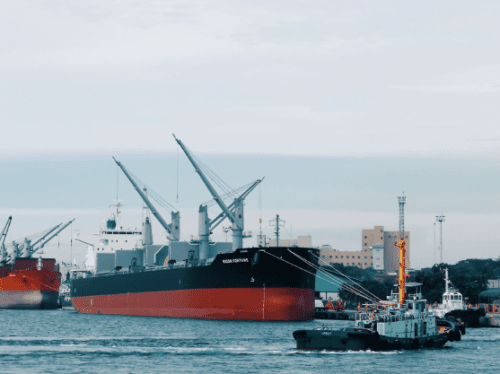TEU: Definition, History, and Vessel Sizes

TEU, or a twenty foot equivalent unit, is the standard measure of container capacity on a ship. In other words, it tells you how many 20-foot-long containers can fit on particular container ships. TEU is important because it allows for easy comparison of vessel sizes.
For example, if one container ship has a capacity of 1,000 TEU and another container ship has a capacity of 2,000 TEU, you know that the second ship can hold twice as many containers. In this blog post, we’ll take a closer look at the history and development of TEU as a measure of capacity on container ships.
We’ll also examine some of the largest vessels in the world and see just how much cargo they can carry. So whether you’re a maritime enthusiast or just curious about how big these ships are, read on for everything you need to know about TEU.
What Is TEU?
A TEU is a standard size for a shipping container. It stands for “twenty-foot equivalent unit” and is the most common type of container used on cargo ships. Therefore, TEUs are sometimes called “unit loads” or “intermodal containers.” A TEU measures 20 feet long, 8 feet wide, and 8 feet tall. TEUs are used to measure the capacity of a ship or the amount of freight a vessel can carry. For example, a ship carrying 3,000 TEUs of cargo is said to have a capacity of 3,000 TEUs.
The term “TEU” also is used to describe the number of containers loaded onto or discharged from a ship simultaneously. For example, if a vessel is loaded with 1,000 20-foot containers, the ship’s load is said to be 1,000 TEUs.
The History of TEU
Malcolm McLean’s idea for standard-sized containers that one can use for multiple forms of transportation revolutionized the shipping industry. Before his innovation, commodities were loaded and unloaded by hand, often resulting in damage or lost cargo.
By designing containers that people could quickly transfer between modes of transport, McLean created a more efficient and reliable system for shipping goods. As a result, a new era in ocean freight began in April 1956 when the Ideal X set sail on the inaugural journey of containerized cargo from New Jersey to Houston.
His idea soon caught on, and today, people use TEU containers worldwide. Over 80 years after McLean founded it, TEU remains an essential part of the global shipping industry, transporting billions of tons of cargo annually. McLean’s visionary thinking has transformed what was once a time-consuming and unreliable process into a streamlined and efficient operation.
TEU in Vessel Size and Carrying Capacity
Here are various vessel sizes and how TEU categorizes them.
- Small Feeder: This feeder has a carrying capacity of 300 TEUs.
- Feeder: These vessels have a capacity of less than 500 TEUs.
- Feedermax: These vessels have a capacity of 500-999 TEUs.
- Panamax Vessels: These vessels have a capacity of more than 3,000 TEUs
- Post-Panamax Vessels: These vessels have a capacity of 3,000- 7,999 TEUs. Others range from 8,000-9,999 TEUs
- Super Post-Panamax: These vessels have a capacity of over 10,000 TEUs.
TEU Vs. FEU
FEU is an acronym for “forty-foot equivalent unit.” It is a measure used for containerized maritime cargo. FEU is the standard size of most intermodal shipping containers. Shippers use these containers to transport goods by ship, rail, or truck.
An FEU container is 40 feet long, 8 feet wide, and 8 feet 1 inch tall. That equals 2,360 cubic feet. Therefore, an FEU container’s tare weight, or empty weight, is 8159 pounds (3700.86 kgs).
Some shippers use Forty-foot High Cube Containers (HC), one foot taller than standard FEUs.

When to Use FEU
It is best to only use FEU when it benefits the shipper. An advantage of using FEU is that multiple containers can be stuffed and shipped together on the same vessel under one Bill of Lading. Using one bill of lading for numerous containers saves on documentation and reduces delays at ports.
In addition, because FEUs are a standard size, you can easily transfer them between different types of transportation without having to repack them.
Another benefit is that shippers can calculate the cost of shipping per unit volume, which allows them to compare the cost-effectiveness of using different-sized containers. Lastly, FEU provides for more efficient use of limited terminal spaces.
Disadvantages of Using FEUs
There are some disadvantages associated with using FEUs. First off, they may not always be available when you need them since other shippers have first dibs on them.
Secondly, if your product doesn’t fit well in an FEU, it can lead to wasted space and unused capacity, which increases shipping costs. Lastly, transporting goods in an FEU requires specialized equipment, such as chassis and winches, which can add to the overall cost of shipping.
When shipping internationally, you must consider all variables to select the best possible option for your business. However, in many cases using an FEU will be the best option as it offers several advantages with few disadvantages.
Difference Between FEU and TEU
TEU and FEU are both measures of container capacity. TEU stands for “twenty-foot equivalent units” and measures how many 20-foot containers can fit in a given space. FEU stands for “forty-foot equivalent units” and measures how many 40-foot containers can fit in a given space.
Given that one TEU is equal to two FEUs, it follows that an FEU is twice the size of a TEU. Thus, an FEU can hold twice as many containers as a TEU.
Therefore, when measuring the capacity of a container ship or port, it is essential to use the appropriate unit so that apples are being compared to apples.

Conclusion
McLean’s visionary thinking has resulted in a more efficient and reliable system for shipping goods used worldwide today. His idea of using TEU containers quickly caught on, transforming the global shipping industry into what it is today. Thanks to McLean’s innovative thinking, cargo can be transported much more quickly and efficiently than ever before.
